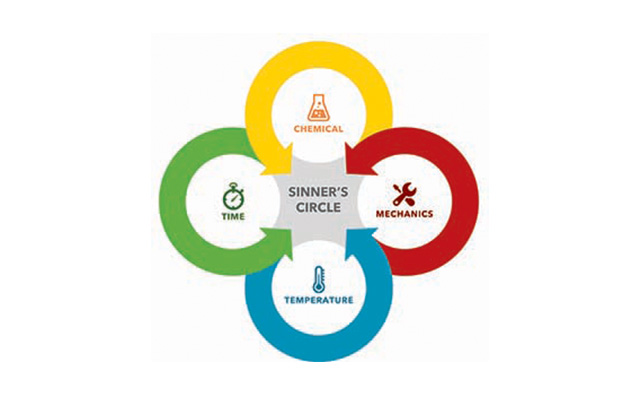Industry News, HI&I Cleaning Care
THE IMPACT OF SINNER’S CIRCLE

Industry News, HI&I Cleaning Care

Image: CleanFax
In the movie The Matrix, humanity’s consciousness has been hijacked by computers, which have created a fake world. The plot is about humans finding that all they thought they knew was actually a counterfeit world called the “Matrix.”
The carpet cleaning industry has its own “Matrix.” Thinking of the cleaning products we use, the chemistries of cleaning, we are sometimes confused.
The familiar term that we use, the “fundamentals of soil suspension,” is a deviation of the “basics of cleaning” that was created by Dr. Hubert Sinner in 1959. His concept is known as “Sinner’s Circle,” the commonly accepted work that other cleaning industries are using.
The fundamentals of soil suspension and the basics of cleaning both have four elements. The fundamentals of soil suspension elements are:
At first glance, there appears to be only two deviations. “Agitation” has been substituted for “mechanics,” and “heat” for “temperature.”
These are slight changes, so where is the problem? Often, the problem is missed because it is too obvious. The problem is in the name. “Suspension” is one of the “chemistries” of cleaning. This substitution becomes problematic when one looks at other cleaning chemistries. The definitions of the other forms of chemistry get altered.
It is recognized in two issues (in 2016 and 2017) of The Journal of Cleaning, Restoration & Inspection that suspension is only one form of chemistry of cleaning.
The complete list should include:
This occurs when solids are suspended in a liquid. This means the cleaning solution is a liquid, while the soil is insoluble or always a solid.
This enables the mixture of two immiscible liquids such as oil in water.
This creates a liquid solution when a substance homogeneously mixes into a solvent. This means that the detergent is a liquid and the soil is soluble. Dissolving is also unique from suspension and emulsification in that it removes absorbed soils such as oils in oleophilic fibers. There is no form of suspension here.
This occurs when a solid attracts other substances into itself without changing their state. This means that the detergent is a solid. This is a daunting concept for some because some consider absorption to be a chemical-free method of cleaning. Absorption is also unique from suspension and emulsification in that it also removes absorbed soils such as oils in oleophilic fibers. Polarity plays a part in absorption.
This changes substances into films or crystals. Thus, the detergent is a liquid, which becomes a solid. The chemical that achieves encapsulation is called an encapsulant.
This results in new substances being created — two or more atoms (or compounds) combine to make a new, pure substance, or a pure substance breaks down into two or more individual atoms (or compounds).
It should be self-evident that the definitions of these forms of chemistry make them all unique from each other. To rename Sinner’s work the “fundamentals of soil suspension,” one must say that dissolving, absorption, and encapsulation are all forms for suspension and that they all are chemical reactions.
The “fundamentals of soil suspension” give us a taste of reality but keep us from seeing its full meaning. To broaden our understanding, the impact of Sinner’s Circle should be examined and embraced.
It’s something to think about.